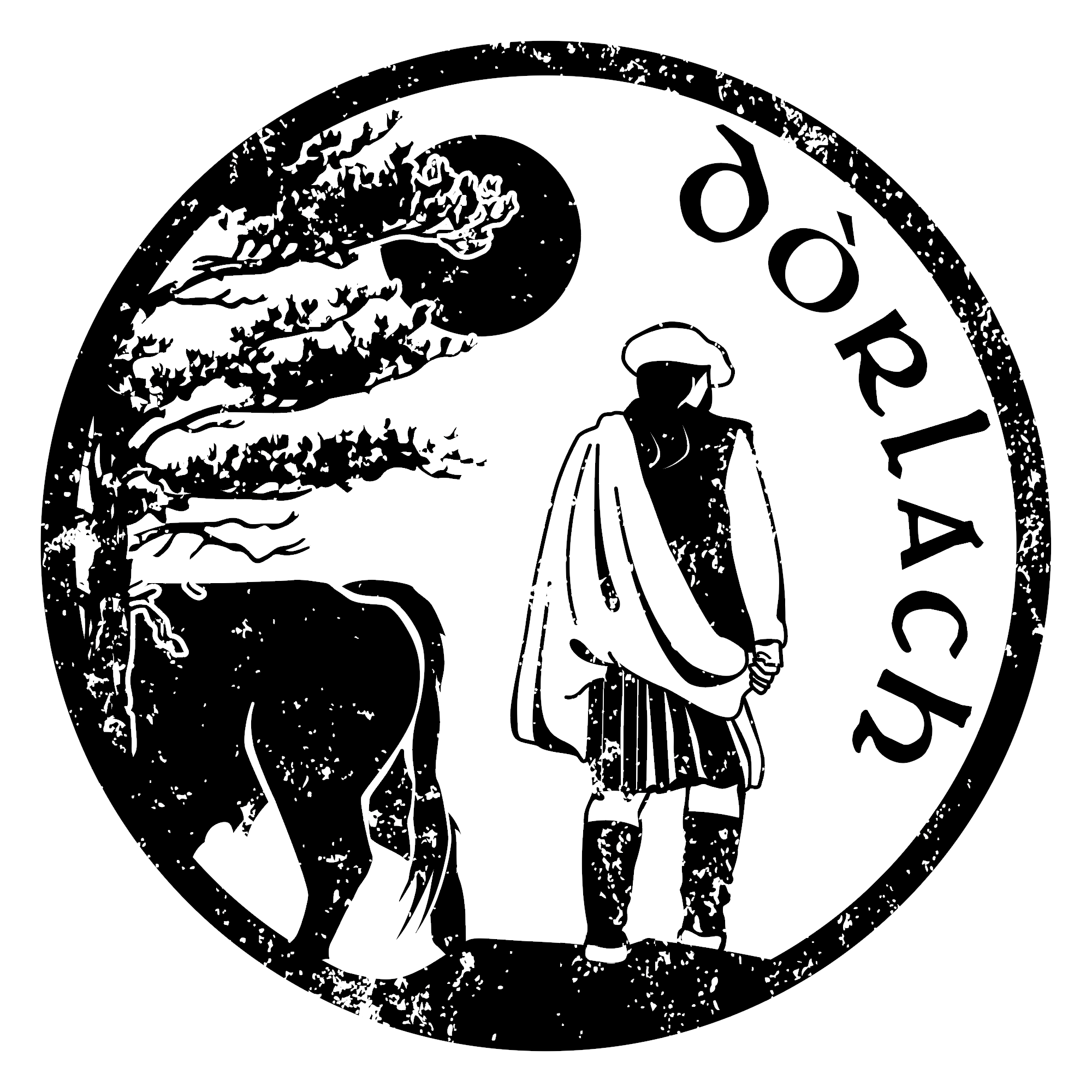when I arrived. If nothing else, I had been there, spent time with two
wonderful people who spoke from out of the marrow of the place and even if heaven
forbid a revival of the dialect never took place I could say with certainty that
I drank of the Melness spring while it still ran, trickle or no.
the night and spend an hour furiously scribbling everything I could remember
into my notebook. It might all come out turach
air tharach (topsy-turvy) as they say in Lios Mór (Lismore), but I didn’t think Nan and Nellie would mind.
traversed grey mountain and rusty moor on the road to Diùranais (Durness). There was incredible warmth in that statement
and it helped to further allay the cultural alienation which has been the last
100 years of my own family’s history.
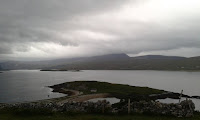 |
| Geodh’ an Sgadain agas Eilean Choraidh |
It had started to rain. I flicked the car
wipers up a notch and took it easy along the single track road, meeting barely
a soul on the way. I have been in many places where the rain was no hindrance
to the beauty of the landscape, but there are few places in the world which
seem to claim the rain as their own. The MacKay Country is one of them. The
swirling mist round the tops of resolute peaks and stacks is as expressive of
the Gaelic mindset as our music and song. It’s all one rhythm. And it makes me
feel completely at home.
Highlander (read: “Gael”) a girl
from Lewis who couldn’t speak Gaelic once said to me. The memory of that
statement has remained something to make me chuckle, albeit ironically.
Despite the fact that I didn’t rise to it at the time, I could have scrambled through all manner of circumstantial evidence as to why it was not true. At any table of born and bred Highlanders I could sit very comfortably and count myself among them as my people hail almost exclusively from Ireland and Highland Caithness. I grew up in Argyll which if not a Highland county would struggle to be categorised otherwise. We kept hens, fished in the loch and grew potatoes at the side of the house. However when it comes right down to it, it also has a lot to do with mindset, something that is learned from spending time around people who can’t think any other way and treating them and their wisdom like they matter. That’s when they open up, begin to share and you feel your soul growing by the minute just being in their presence. The problem is that in the Highland context, mindset and language are becoming almost irreparably severed from identity. Just as well I can chuckle about it, bheireamh e na deòir ort! (it would bring the tears on you!).
leann (ale) were most definitely in
order while I put down my notes. I had a grand bar meal, began to sup and the lines flowed.
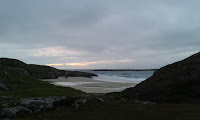 |
| Tràigh na h-Uamhag, Diùranais |
During my early teens my grandmother realised
that I was becoming increasingly interested in history and genealogy. She explained
that we belonged to the MacLeods, that they were our “clan”. I know now of
course that this was a modern, romantic perception of things, but there were
some interesting family traditions associated with it nonetheless.
Assynt, gran used to say. The story was that we migrated out of Srath Nabhair (Strathnaver), that the MacLeods came down to
Caithness from the Sutherland glens before Na Fuadaichean (the Clearances) began and settled in Hàcraig (Halkirk) before making for the coast. Not only that, but they were said to hail from Assynt originally. It’s difficult to imagine why
there wouldn’t be at least some truth in this, although I haven’t managed to
look deeply enough into it just yet.
Who were these MacLeods of Assynt? I quickly learned that their main stronghold
during the 16th and 17th centuries was Àrd Bhreac (the speckled bluff,
Ardvreck) on Loch Asaint (Loch
Assynt). Delving into the history of the castle, one incedent sticks out above
all. This was where Montrose had allegedly been betrayed to the Covenanters by
one Niall MacLeòid (Neil MacLeod),
Laird of Assynt.
hours of it had already passed and I hobbled down the hotel stairs for some
scrambled egg and toast. Far, far too many drams last night. Too many pints.
Whatever the heck else had been going. I had strapped on my guitar and sung my
heart out. Classics from the 60s and 70s and a few Gaelic songs too. I hadn’t
bought a drink all night. The folk up there know how to look after a singer.
One or two on the house for the troubador and a good few from about the room
too. Fella from Glasgow who thought he was a Patter-merchant. Heckling. Gave
just as good as I got. Head alright. Stomach needing filled. Not quite legal to
drive yet. Toast, egg and pan-fried mushrooms choked down. Half a cigarette someone
had rolled me still in my pocket from the previous night, flat and flaky, puffed
out the side door. Straightening out. Beag
air bheag (little by little).
my MacLeod ancestry from this incedent between the Laird of Ardvreck and
Montrose. There is no doubt that he and Alasdair
mac Colla chiotaich (Alasdair MacColla) were a formidable team and easy to
admire despite the ego and brutality respectively. It is frankly criminal how
little MacColla is celebrated in comparison to the likes of Wallace. Because he
doesn’t fit in with the Lowland conception of what a Scottish hero should be,
he is blithely ignored. Montrose fits in fine and is celebrated. In all
fairness, rightly so. To think that my ancestors had turned him over to the
enemy filled my teenage self with resentment. It’s all about good and bad at
that age, and complicated politics flies overhead without so much as a nod.
Growing up with American cartoons as a constituent of your moral compass
certainly leaves its legacy.
copious amounts of coffee and as the air struck me, realised that my head was
clear. Since the zero tolerance policy kicked in, I have not been willing to
take any chances. It was wet again and I hadn’t much time. I wanted to make it
into Assynt proper and assess the situation. I made off out of Durness, having
had a cracking night’s entertainment and hospitality and took the long road
round the north-west corner of Sutherland. The county had been good to me so
far once again.
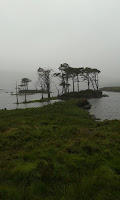 |
| Loch Asainte |
There is something incredibly dramatic about
the situation of Ardvreck Castle. You hit the road that runs along the shores of
Loch Assynt having emerged out of the MacKay Country and have to take a left back
towards the hinterland of Sutherland to reach the castle. Today was one of
those days when despite the lack of blue sky, the colours that remained through
the rain and mist were just right for my mood and inclination. The water of the
loch was a solid slate colour with the slumbering mountains rising from behind its shores
and the shattered tower of MacLeod on a little outcrop on the northern side; no
doubt the àrd bhreac that gave the
castle its name. I got out of my car in the parking area and passed a number of
Germanic-speaking tourists as I approached Ardvreck with whom I exchanged
pleasantries in Dutch and Swedish.
never looked under the surface of this tale, never affirmed nor disaffirmed its
veracity. Looking into it 20-odd years later and it seems that the real story of Montrose’s
betrayal was well-known amongst the Gaels of Assynt. In 1650, Montrose was a fugitive
after the disastrous Battle of Carbisdale and was starving. He had arrived in
Assynt broken and exhausted and had given himself up to some locals who proceeded to
bring him to Ardvreck.
the castle; it is today entirely isolated. As I wandered without a jacket,
letting the misty smùgraich (light
rain) soak into my t-shirt and the chilly osnaich
(breeze) envelop me, I imagined what it must have been like for the shattered,
strung-out Montrose to arrive at this desolate outpost. That said, things would
have been different in the past. As a Gael, I am in full knowledge of just how
many smallholdings there would have been right along the shores of the loch.
Just west of the castle were the settlements at Acha’ Mór (Big Field), which would have housed some dozens of
Gaelic-speaking people before they were cleared to the coast between 1812 and
1821. This would not have been an “isolated” spot at all for a visiting Gael,
it would have been a community into which a man would arrive and be shown just the
same hospitality I had found in Melness.
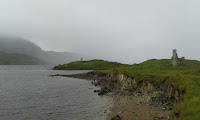 |
| Caisteal Àrd Bhric ri taobh an loch |
There were however two differing factors for
Montrose. The first was that his identity would have been cast into immediate question
due to his -at best- broken Gaelic and most certainly his attire, however ragged
by that point. He was born in Edinburgh in 1612, in the reign of James VI and in
an age when Highlanders were looked upon as no more integral to Scotland
than a migraine in the head of its sufferer. Montrose would have stuck out like
a sore thumb as he dragged his failing carcass into Assynt. While he would have
been well-adjusted to Highland ways after his months serving alongside MacColla
–the Gael par excellence– and would
no doubt have picked up some conversational Gaelic, he would not have gone
unnoticed as at the very least a Gall
(Lowlander) in the depths of the Highlands.
was politically-speaking hot property. Upon arriving at the house of one of the
Assynt smallholders, it would have been folly for Montrose’s host not to
consult the laird over what to do with his guest. Any attempt to conceal his
identity would have been hindered not only by the factors discussed above but
perhaps by a plea from Montrose himself in the hope of assistance from
potentially sympathetic Gaels. The only way his host’s hands would not have been
tied would have been if Montrose had stumbled by chance on the home of a
staunch Royalist.
 |
| Àrd Bhreac ri linn Niall MhicLeòid |
Ardvreck Castle is more or less rent from top
to bottom. It appears as if some of its stone was utilised for the building of An Taigh Geal (The White [Calda] House)
nearby. When Montrose arrived, it would
have been in its heyday, but still fairly small in comparison with some of the
more famous edifices to the south. When the loch is high, the castle can
occasionaly become cut off from the mainland and as I walked round the building,
it was clear that the waves often lapped close to the foundations. It is said that
Montrose was brought across the moors to the building by his host, who had
promised to take him to the MacKay Country. We do not know if Montrose really
expected hospitality from the MacLeods as the very fact that Neil had not come
out for him –he had only just come of age- suggests that he expected at the
very least a neutral reception.
into the MacLeods- was a Calvinist and somewhat hostile to Royalists. Her
husband Neil is said to have been some sixty miles away when the Marquis
arrived. It was known that Montrose had suffered defeat at Carbisdale and one
of the enemy number was a Captain Munro who happened to be the brother of Lady
MacLeod and in regular communication with his sister. Whether Neil MacLeod was
directly involved in subsequent events is not altogether clear, but it is
certainly known that he suffered the reputation of a traitor ever after.
MacLeod was in a sticky position at the time. He was being more or less
coerced into partnership with the Earl of Sutherland and the encroaching
MacKenzies of Ross-shire had already begun usurping MacLeod lands in Lewis with
Assynt soon to follow. Whatever his role in events, what Neil did not have was a clean choice on his hands
and it is in truth pretty likely that he had no choice at all. The life that
followed the Montrose scandal was a very tough one for MacLeod and I now believe that the title of traitor is
nothing if not a little harsh.Click here to continue reading
